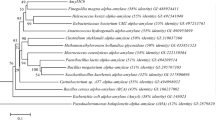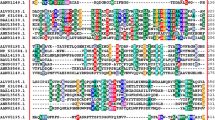Abstract
Intracellular and extracellular proteins from halophilic archaea face very saline conditions and must be able to maintain stability and functionality at nearly saturated salt concentrations. Haloarchaeal proteins contain specific adaptations to prevent aggregation and loss of activity in such conditions, but these adaptations usually result in a lack of stability in the absence of salt. Here, we present the characterisation of a secreted α-amylase (AmyH) from the halophilic archaeon Haloarcula hispanica. AmyH was shown to be very halophilic but, unusually for a halophilic protein, it retained activity in the absence of salt. Intrinsic fluorescence measurements and activity assays showed that AmyH was very stable in high-salt buffer and even maintained stability upon the addition of urea. Urea-induced denaturation was only achieved in the absence of NaCl, demonstrating clearly that the stability of the protein was salt-dependent. Sequencing of the amyH gene showed an amino acid composition typical of halophilic proteins and, moreover, the presence of a signal peptide containing diagnostic features characteristic of export via the Twin-arginine translocase (Tat). Analysis of the export of AmyH showed that it was translocated post-translationally, most likely in a folded and active conformation, confirming that AmyH is a substrate of the Tat pathway.







Similar content being viewed by others
References
Bolhuis A (2002) Protein transport in the halophilic archaeon Halobacterium sp. NRC-1: a major role for the twin-arginine translocation pathway? Microbiology 148:3335–3346
Coronado MJ, Vargas C, Mellado E, Tegos G, Drainas C, Nieto JJ, Ventosa A (2000) The alpha-amylase gene amyH of the moderate halophile Halomonas meridiana: cloning and molecular characterization. Microbiology 146:861–868
Edens L, Heslinga L, Klok R, Ledeboer AM, Maat J, Toonen MY, Visser C, Verrips CT (1982) Cloning of the cDNA encoding the sweet-tasting plant protein thaumatin and its expression in Escherichia coli. Gene 18:1–12
Eisenberg H (1995) Life in unusual environments: progress in understanding the structure and function of enzymes from extreme halophilic bacteria. Arch Biochem Biophys 318:1–5
Fukuchi S, Yoshimune K, Wakayama M, Moriguchi M, Nishikawa K (2003) Unique amino acid composition of proteins in halophilic bacteria. J Mol Biol 327:347–357
Fukushima T, Mizuki T, Echigo A, Inoue A, Usami R (2005) Organic solvent tolerance of halophilic alpha-amylase from a haloarchaeon, Haloarcula sp. strain S-1. Extremophiles 9:85–90
Good WA, Hartman PA (1970) Properties of the amylase from Halobacterium halobium. J Bacteriol 104:601–603
Juez G, Rodriguez-Valera A, Ventosa A, Kushner DJ (1986) Haloarcula hispanica spec. nov. and Haloferax gibbonsii spec. nov., two new species of extremely halophilic archaebacteria. Syst Appl Microbiol 8:75–79
Kobayashi T, Kanai H, Aono R, Horikoshi K, Kudo T (1994) Cloning, expression, and nucleotide sequence of the alpha-amylase gene from the haloalkaliphilic archaeon Natronococcus sp. strain Ah-36. J Bacteriol 176:5131–5134
Kobayashi T, Kanai H, Hayashi T, Akiba T, Akaboshi R, Horikoshi K (1992) Haloalkaliphilic maltotriose-forming alpha-amylase from the archaebacterium Natronococcus sp. strain Ah-36. J Bacteriol 174:3439–3444
Kyhse-Andersen J (1984) Electroblotting of multiple gels: a simple apparatus without buffer tank for rapid transfer of proteins from polyacrylamide to nitrocellulose. J Biochem Biophys Methods 10:203–209
Lanyi JK (1974) Salt-dependent properties of proteins from extremely halophilic bacteria. Bacteriol Rev 38:272–290
Lezhava A, Mizukami T, Kajitani T, Kameoka D, Redenbach M, Shinkawa H, Nimi O, Kinashi H (1995) Physical map of the linear chromosome of Streptomyces griseus. J Bacteriol 177:6492–6498
Lichi T, Ring G, Eichler J (2004) Membrane binding of SRP pathway components in the halophilic archaea Haloferax volcanii. Eur J Biochem 271:1382–1390
MacGregor EA, Janecek S, Svensson B (2001) Relationship of sequence and structure to specificity in the alpha-amylase family of enzymes. Biochim Biophys Acta 1546:1–20
Madern D, Ebel C, Zaccai G (2000) Halophilic adaptation of enzymes. Extremophiles 4:91–98
Mevarech M, Frolow F, Gloss LM (2000) Halophilic enzymes: proteins with a grain of salt. Biophys Chem 86:155–164
Pang KM, Knecht DA (1997) Partial inverse PCR: a technique for cloning flanking sequences. Biotechniques 22:1046–1048
Perez-Pomares F, Bautista V, Ferrer J, Pire C, Marhuenda-Egea FC, Bonete MJ (2003) Alpha-amylase activity from the halophilic archaeon Haloferax mediterranei. Extremophiles 7:299–306
Polosina YY, Zamyatkin DF, Kostyukova AS, Filimonov VV, Fedorov OV (2002) Stability of Natrialba magadii NDP kinase: comparisons with other halophilic proteins. Extremophiles 6:135–142
Robinson C, Bolhuis A (2004) Tat-dependent protein targeting in prokaryotes and chloroplasts. Biochim Biophys Acta 1694:135–147
Rose RW, Brüser T, Kissinger JC, Pohlschröder M (2002) Adaptation of protein secretion to extremely high-salt conditions by extensive use of the twin-arginine translocation pathway. Mol Microbiol 45:943–950
van der Maarel MJEC, van der Veen B, Uitdehaag JCM, Leemhuis H, Dijkhuizen L (2002) Properties and applications of starch-converting enzymes of the alpha-amylase family. J Biotechnol 94:137–155
Woods WG, Ngui K, Dyall-Smith ML (1999) An improved transposon for the halophilic archaeon Haloarcula hispanica. J Bacteriol 181:7140–7142
Acknowledgements
We thank Drs. Teresa Pinheiro and Judith Thomas for stimulating discussions, Pete Cain for critical reading of the manuscript, and Mike Dyall-Smith for providing H. hispanica and the plasmid for transposon mutagenesis. This work was supported by a Biotechnology and Biological Sciences Research Council studentship to G.H. and a Royal Society University Research Fellowship to A.B.
Author information
Authors and Affiliations
Corresponding author
Additional information
Communicated by A. Driessen
Rights and permissions
About this article
Cite this article
Hutcheon, G.W., Vasisht, N. & Bolhuis, A. Characterisation of a highly stable α-amylase from the halophilic archaeon Haloarcula hispanica. Extremophiles 9, 487–495 (2005). https://doi.org/10.1007/s00792-005-0471-2
Received:
Accepted:
Published:
Issue Date:
DOI: https://doi.org/10.1007/s00792-005-0471-2




